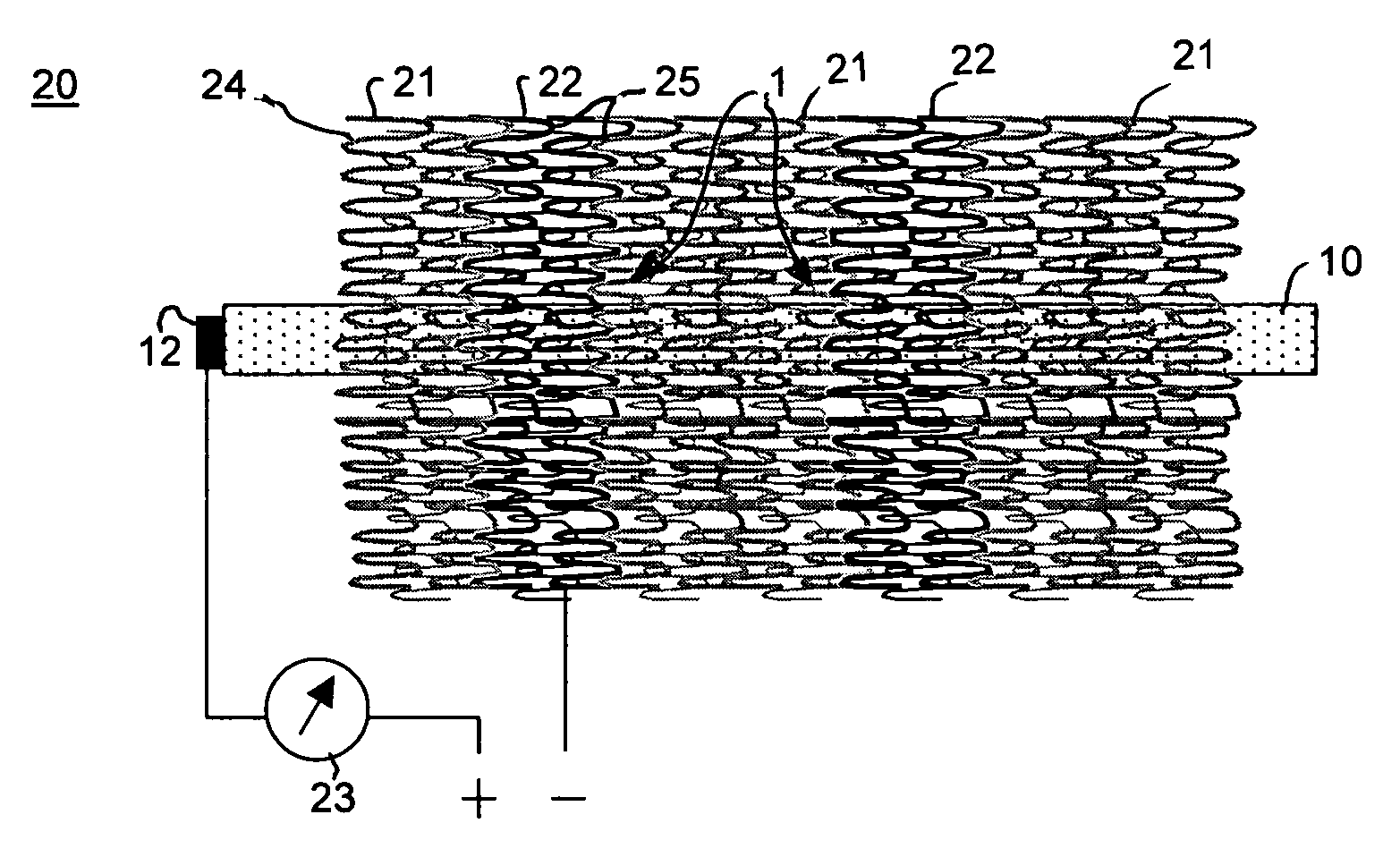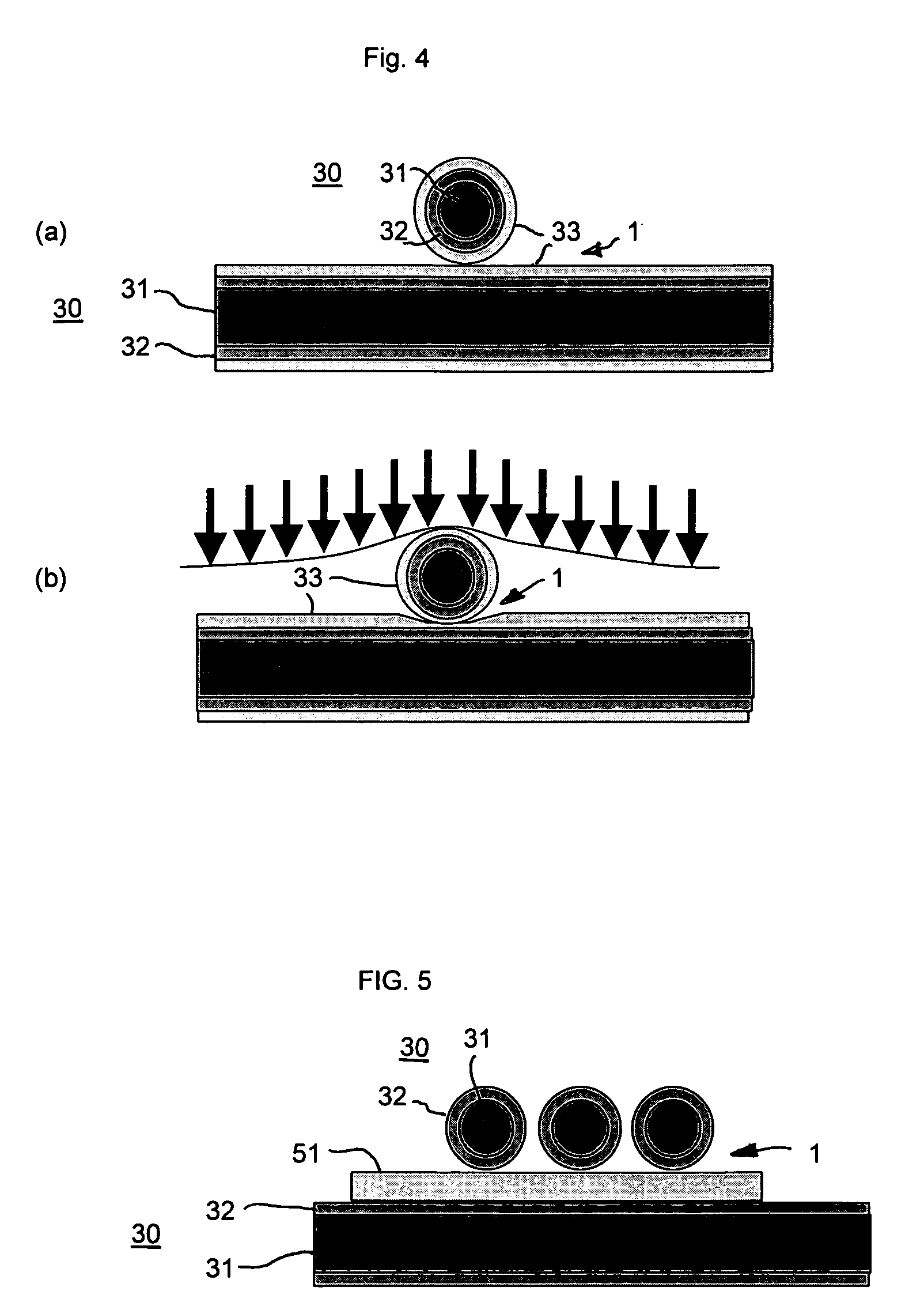Pressure sensor
a pressure sensor and pressure sensor technology, applied in the field of pressure sensors, can solve the problems of difficult control of pressure thresholds, inability to accurately measure applied pressure over a sufficiently wide range, etc., and achieve the effect of reliable pressure or force measurement results
- Summary
- Abstract
- Description
- Claims
- Application Information
AI Technical Summary
Benefits of technology
Problems solved by technology
Method used
Image
Examples
first embodiment
[0019]A textile pressure sensor in accordance with the invention is shown in FIGS. 1, and 2. This sensor includes a multilayer thread being a fine strip of laminated film 10, incorporated into a fabric 20.
[0020]FIG. 1 shows a cross-sectional view of the laminated film 10. The laminated film 10 comprises a core made of an electrically conductive layer 12. Both surfaces of the conductive layer 12 are covered by pressure sensitive layers 11.
[0021]The outer surfaces of the pressure sensitive layers 11 are covered by electrically conductive electrode layers 13. The pressure sensitive layers 11 are made of an electrically conductive elastic material that shows a pressure-dependent resistance between the conductive layer 12 and the electrode layers 13. The material may be a conductive polymer like polyaniline. Another preferred material is an elastic insulator such as silicone, including conductive filler particles such as carbon black particles. As an alternative, the pressure sensitive l...
second embodiment
[0028]FIG. 6 shows the structure of the multilayer thread 30 of the second embodiment in more detail. The polymer fiber 31 forming the core of the thread comprises a multitude of filaments 34. The core is coated by the conductive coating 32 made of a good conductor, preferably a metal such as aluminum, copper or, preferable, silver. The conductive coating 32 is, in turn, covered by a pressure sensitive coating 33 made of an elastic material having an electric resistivity in between that of a good conductor such as a metal, and that of an insulator. It may be made of a conductive polymer such as polyaniline, or of an insulating polymer or elastomer containing conductive filler particles, such as silicone containing carbon black particles. Thus, the electric resistance measured in radial direction of the thread 30 between the conductive coating 32 and the outer surface of the pressure sensitive coating 33 depends on the thickness of the pressure sensitive coating 33 and thus on the de...
fourth embodiment
[0029]FIG. 7 shows a sock 70 as an example of a garment incorporating a pressure sensor in accordance with the invention. The sock 70 is made of a knitted fabric mainly consisting of insulating yarn such as cotton, wool or synthetic fiber. Incorporated into the fabric are filler threads extending in longitudinal direction spaced apart and parallel to each other. The filler threads are made of the multilayer threads 30 shown in FIGS. 3 and 6. Further incorporated into the fabric are warp threads made of conductive: threads 25 which extend in generally horizontal, direction of the sock along spaced apart conductive zones 22 in the way as shown in FIG. 2. Thus, the fabric of the sock 70 resembles that of FIG. 2 except that the strip of laminated film 10 of the FIG. 2 embodiment is replaced by a multilayer thread 30 of the FIG. 3 embodiment.
[0030]When the conductive threads 25 and the multilayer threads 30 are connected to an electronic circuit as disclosed in DE 103 14 211 A1, the circ...
PUM
| Property | Measurement | Unit |
|---|---|---|
| pressure | aaaaa | aaaaa |
| electric characteristic | aaaaa | aaaaa |
| pressure sensitive | aaaaa | aaaaa |
Abstract
Description
Claims
Application Information
 Login to View More
Login to View More - R&D
- Intellectual Property
- Life Sciences
- Materials
- Tech Scout
- Unparalleled Data Quality
- Higher Quality Content
- 60% Fewer Hallucinations
Browse by: Latest US Patents, China's latest patents, Technical Efficacy Thesaurus, Application Domain, Technology Topic, Popular Technical Reports.
© 2025 PatSnap. All rights reserved.Legal|Privacy policy|Modern Slavery Act Transparency Statement|Sitemap|About US| Contact US: help@patsnap.com



